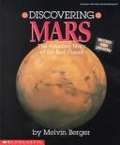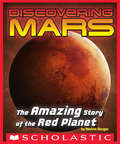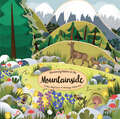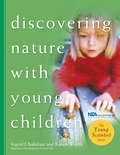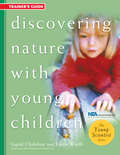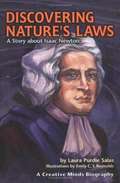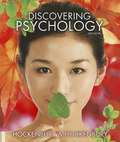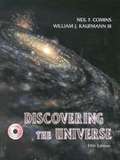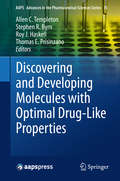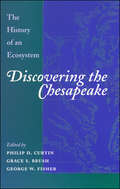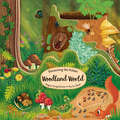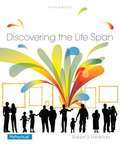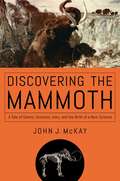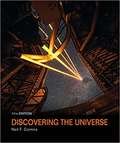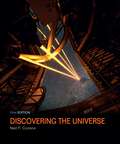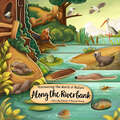- Table View
- List View
Discovering Mars: A History of Observation and Exploration of the Red Planet
by William Sheehan Jim BellFor millenia humans have considered Mars the most fascinating planet in our solar system. We’ve watched this Earth-like world first with the naked eye, then using telescopes, and, most recently, through robotic orbiters and landers and rovers on the surface. <p><p>Historian William Sheehan and astronomer and planetary scientist Jim Bell combine their talents to tell a unique story of what we’ve learned by studying Mars through evolving technologies. What the eye sees as a mysterious red dot wandering through the sky becomes a blurry mirage of apparent seas, continents, and canals as viewed through Earth-based telescopes. Beginning with the Mariner and Viking missions of the 1960s and 1970s, space-based instruments and monitoring systems have flooded scientists with data on Mars’s meteorology and geology, and have even sought evidence of possible existence of life-forms on or beneath the surface. This knowledge has transformed our perception of the Red Planet and has provided clues for better understanding our own blue world. <p><p>Discovering Mars vividly conveys the way our understanding of this other planet has grown from earliest times to the present. The story is epic in scope—an Iliad or Odyssey for our time, at least so far largely without the folly, greed, lust, and tragedy of those ancient stories. Instead, the narrative of our quest for the Red Planet has showcased some of our species’ most hopeful attributes: curiosity, cooperation, exploration, and the restless drive to understand our place in the larger universe. Sheehan and Bell have written an ambitious first draft of that narrative even as the latest chapters continue to be added both by researchers on Earth and our robotic emissaries on and around Mars, including the latest: the Perseverance rover and its Ingenuity helicopter drone, which set down in Mars’s Jezero Crater in February 2021.
Discovering Mars: The Amazing Story of the Red Planet
by Melvin BergerThis book talks about the features, history, and current and future exploration of Mars. [This text is listed as an example that meets Common Core Standards in English language arts in grades 4-5 at http://www.corestandards.org.]
Discovering Mars: The Amazing Story of the Red Planet (Journeys 2014)
by Melvin Berger Mary Kay CarsonRecognized as an exemplar text by the Common Core State Standards, this updated version of DISCOVERING MARS features a new cover and the latest information and discoveries about the red planet.Featuring incredible photos and new information about the latest research into Mars, this updated edition of DISCOVERING MARS covers everything about the great red planet, from past to present.Topics covered include myths and facts about life on Mars, a history of NASA's Mars research, including the Rover missions, and ideas about our potential future relationship with the planet. With its lively text narrative and beautiful color photos, students and teachers alike will enjoy learning everything there is to know about Mars.
Discovering Nature on the Mountainside
by Lenka Chytilová Hedviga GutierrezThis beautifully illustrated and educational children&’s book explores mountain wildlife and how different animals live through the seasons. Strap on your boots and set out to explore a gorgeous mountainside! Discover all the amazing animals that call the mountains home. See how they live throughout the seasons—from bears and bats to eagles, mountain goats, marmots, and so much more. From which animals turn white when it snows to which are the best ice and rock climbers, young readers will learn all kinds of fun facts in this delightful picture book. This is a fixed-format ebook, which preserves the design and layout of the original print book
Discovering Nature with Young Children
by Karen Worth Ingrid ChalufourField-tested across the country, this comprehensive curriculum expands and extends the role science has traditionally played in the early childhood classroom. The first in a new series, Discovering Nature with Young Children explores the wide-ranging elements that make up the natural world around us. The curriculum replaces simple fact-feeding practices with the development of long-term scientific reasoning, including literacy skills and numeracy skills, such as hypothesis, inference, prediction, and estimation.
Discovering Nature with Young Children: Trainer's
by Karen Worth Ingrid ChalufourField-tested across the country, this comprehensive curriculum expands and extends the role science has traditionally played in the early childhood classroom. The first in a new series, Discovering Nature with Young Children explores the wide-ranging elements that make up the natural world around us. The curriculum replaces simple fact-feeding practices with the development of long-term scientific reasoning, including literacy skills and numeracy skills, such as hypothesis, inference, prediction, and estimation. A companion to the curriculum, this trainer's guide serves as an indispensable handbook for trainers and administrators interested in introducing staff to the curriculum--from planning to implementation. Special sections outline the curriculum and introduce scientific reasoning to adults, and eight workshops detail the complete curriculum for staff members. The guide also includes strategies for supporting teachers over time through mentoring and guided discussions.
Discovering Nature's Laws: A Story about Isaac Newton
by Laura Purdie SalasSir Isaac Newton changed the world with his many discoveries and inventions about mathematics, science, optics, and physics. Although he was brilliant, Newton felt no need to publish his ideas or to inform his fellow scientists of the amazing discoveries he made. Because of this, his discoveries were often disputed. Despite the controversy that often surrounded him, Newton made astounding advances in his efforts to understand how nature worked. His legacy lives on through inventions such as microscopes, eyeglasses, telescopes, and cameras.
Discovering Odors
by Gérard BrandOften taken for granted, the sense of smell has seldom been discussed or understood. However, since the start of the 20th Century, studies in this area have grown exponentially and today there is a greater understanding of the olfactory system – at both structural and functional levels. Scientists now concern themselves with questions about the holistic nature of our sense of smell and are investigating the role of odors in interpersonal relations, in food intake processes, in the diagnosis of certain illnesses, and many other areas. The beginnings of this knowledge are as fascinating as they are abundant and numerous disciplines are involved: psychology, physiology, genetics, neuroscience, engineering, etc. This book illustrates and analyzes the current state of advances in research about the smells around us, and the way in which they influence our relationship with the world.
Discovering Psychology 6th Edition
by Sandra E. Hockenbury Don HockenburyAn introductory Psychology text.
Discovering Retroviruses: Beacons in the Biosphere
by Anna Marie SkalkaEight percent of our DNA contains retroviruses that are millions of years old. Anna Marie Skalka explains how our evolving knowledge of these particles has advanced genetic engineering, gene delivery systems, and precision medicine. Retroviruses cause disease but also hold clues to prevention and treatment possibilities that are anything but retro.
Discovering The Life Span (Second Edition)
by Robert S. FeldmanModular, Manageable, Meaningful- help your students discover the life span! Discovering the Life Span provides students with a strong balance of research and applications. Many instructors would like to cover the entire life span in a single term and help their students see the big picture. They want students to understand how the domains of development work together and perhaps, most importantly, have their students truly connect to the material. This remarkable text does all of this. Its balanced modular format treats each stage of life and each domain equally throughout the text. With 10 chapters, 3 modules per chapter, and only 576 pages, Discovering the Life Span is more manageable for instructors and students. It allows instructors to cover all areas of the life span without having to sacrifice content during their one-term course and students get a better sense of the entire process of development.
Discovering The Universe (Fifth edition)
by Neil F. Comins William J. KaufmannA scientific theory can be independently tested and potentially disproved. Newton's ideas can be tested and potentially disproved by observations and thus qualify as scientific theory. The idea that God created the Earth in six days cannot be tested, much less disproved. It is not a scientific theory but rather a matter of faith.
Discovering and Developing Molecules with Optimal Drug-Like Properties
by Allen C Templeton Stephen R. Byrn Roy J Haskell Thomas E. PrisinzanoThis authoritative volume provides a contemporary view on the latest research in molecules with optimal drug-like properties. It is a valuable source to access current best practices as well as new research techniques and strategies. Written by leading scientists in their fields, the text consists of fourteen chapters with an underlying theme of early collaborative opportunities between pharmaceutical and discovery sciences. The book explores the practical realities of performing physical pharmaceutical and biopharmaceutical research in the context of drug discovery with short timelines and low compound availability. Chapters cover strategies and tactics to enable discovery as well as predictive approaches to establish, understand and communicate risks in early development. It also examines the detection, characterization, and assessment of risks on the solid state properties of advanced discovery and early development candidates, highlighting the link between solid state properties and critical development parameters such as solubility and stability. Final chapters center on techniques to improve molecular solubilization and prevent precipitation, with particularly emphasis on linking physiochemical properties of molecules to formulation selection in preclinical and clinical settings.
Discovering the Chesapeake: The History of an Ecosystem
by George W. FisherWith its rich evolutionary record of natural systems and long history of human activity, the Chesapeake Bay provides an excellent example of how a great estuary has responded to the powerful forces of human settlement and environmental change. Discovering the Chesapeake explores all of the long-term changes the Chesapeake has undergone and uncovers the inextricable connections among land, water, and humans in this unusually delicate ecosystem.Edited by a historian, a paleobiologist, and a geologist at the Johns Hopkins University and written for general readers, the book brings together experts in various disciplines to consider the truly complex and interesting environmental history of the Chesapeake and its watershed. Chapters explore a variety of topics, including the natural systems of the watershed and their origins; the effects of human interventions ranging from Indian slash-and-burn practices to changing farming techniques; the introduction of pathogens, both human and botanical; the consequences of the oyster's depletion; the response of bird and animal life to environmental factors introduced by humans; and the influence of the land and water on the people who settled along the Bay.Discovering the Chesapeake, originating in two conferences sponsored by the National Science Foundation, achieves a broad historical and scientific appreciation of the various processes that shaped the Chesapeake region."Today's Chesapeake Bay is only some ten thousand years old. What a different world it was... when the region was the home of the ground sloth, giant beaver, dire wolf, mastodon, and other megafauna. In the next few thousand years, the ice may form again and the Bay will once more be the valley of the Susquehanna, unless, of course, human-induced changes in climate create some other currently unpredictable condition."—from the Introduction
Discovering the Frontiers of Human-Robot Interaction: Insights and Innovations in Collaboration, Communication, and Control
by Ramana VinjamuriThe field of Human-Robot Interaction (HRI) is rapidly evolving, blurring the lines between human and machine capabilities. Recent advances in computer science, computer vision, artificial intelligence, robotics, brain-computer interfaces, neural engineering, and cognitive science have profoundly transformed HRI. As we stand on the threshold of a new era characterized by increasingly sophisticated human-machine interactions, it becomes imperative to explore the emerging frontiers of this dynamic field. Robots are now entering homes, workplaces, and even battlefields, necessitating a deeper understanding of effective, safe, and ethical human-robot interaction. This book delves into cutting-edge research shaping the future of HRI, representing a collective effort to navigate uncharted territories. Through diverse chapters authored by leading experts, it offers a comprehensive exploration of the latest developments, challenges, and opportunities in HRI. By examining technical, engineering, and methodological challenges, this volume brings together perspectives from researchers, engineers, and designers to provide a comprehensive view of this dynamic field. Aiming to showcase groundbreaking research and spark interdisciplinary dialogue and collaboration, this book is a valuable resource for researchers, engineers, students, and anyone interested in the future of human-robot collaboration. Whether you are a seasoned roboticist, a curious student, or simply interested in future technology, this book offers insights and knowledge to navigate the complex world of human-robot interaction. Join us on this journey of discovery as we navigate the emerging frontiers of human-robot interaction together.
Discovering the Future of Molecular Sciences
by Bruno PignataroA glimpse into the future of the European chemistry research landscape. Fifteen top contributions have been selected for this single volume covering areas of chemistry and materials science. The broad range is presented in an approachable and readable manner equally appropriate for non-specialists on the topic. The overview of intriguing topics includes chemical synthesis and advanced methodologies as well as materials, nanoscience and nanotechnologies.
Discovering the Hidden Woodland World
by Magda Garguláková Martin ŠodjrThis whimsical children&’s book takes young readers on a unique adventure into the forest to see the amazing ecosystem of trees. You&’ve seen plenty of old tree trunks, but have you ever thought about the forest animals and insects who rely on them to survive? With delightful illustrations, educational captions, and vocabulary words, this book reveals some of nature&’s most fascinating secrets. From the important role old tree trunks play in the natural world to which insect loves the taste of rotten wood, how trees tell their life story, and so much more, kids will have a blast seeing trees and tree stumps in a whole new light! This is a fixed-format ebook, which preserves the design and layout of the original print book
Discovering the Life Span
by Robert S. FeldmanDiscovering the Life Span, 3/e by Robert S. Feldman helps students truly connect to the material. Written in an engaging and accessible style and organized in a modular format, this title allows instructors to cover the entire lifespan without having to sacrifice content throughout their course. Students will get a better sense of the entire process of development and understand how the domains of development work together. Discovering the Life Span is a meaningful learning experience that prepares readers to apply content to their personal and future professional lives.
Discovering the Mammoth: A Tale Of Giants, Unicorns, Ivory, And The Birth Of A New Science
by John J. McKayThe fascinating saga of solving the mystery of this ancient animal who once roamed the north country—and has captivated our collective imagination ever since. Today, we know that a mammoth is an extinct type of elephant that was covered with long fur and lived in the north country during the ice ages. But how do you figure out what a mammoth is if you have no concept of extinction, ice ages, or fossils? Long after the last mammoth died and was no longer part of the human diet, it still played a role in human life. Cultures around the world interpreted the remains of mammoths through the lens of their own worldview and mythology. When the ancient Greeks saw deposits of giant fossils, they knew they had discovered the battle fields where the gods had vanquished the Titans. When the Chinese discovered buried ivory, they knew they had found dragons’ teeth. But as the Age of Reason dawned, monsters and giants gave way to the scientific method. Yet the mystery of these mighty bones remained. How did Enlightenment thinkers overcome centuries of myth and misunderstanding to reconstruct an unknown animal? The journey to unravel that puzzle begins in the 1690s with the arrival of new type of ivory on the European market bearing the exotic name "mammoth." It ends during the Napoleonic Wars with the first recovery of a frozen mammoth. The path to figuring out the mammoth was traveled by merchants, diplomats, missionaries, cranky doctors, collectors of natural wonders, Swedish POWs, Peter the Great, Ben Franklin, the inventor of hot chocolate, and even one pirate. McKay brings together dozens of original documents and illustrations, some ignored for centuries, to show how this odd assortment of characters solved the mystery of the mammoth and, in doing so, created the science of paleontology.
Discovering the Secret World of Nature Underground
by Petra Bartíková Marcel KrálikYoung readers discover the fascinating world of animals and insects that live underground in this beautifully illustrated children&’s book. Have you ever wondered what it would be like to be an animal that lives underground? Now you can find out! With each turn of the page, this engaging picture book reveals dozens of adorable illustrations, educational captions, vocabulary words, and more—all exploring the underground habitat of several kinds of animals. From rabbits and mice to badgers, ants, and other insects, children will love learning all about these busy animals that burrow below! This is a fixed-format ebook, which preserves the design and layout of the original print book
Discovering the Unique Geology of the Bergell Alps (GeoGuide)
by Hans-Rudolf Wenk Elizabeth WenkThis book aims to introduce scientists and educated laymen to the fascinating geology of the Bergell Alps, first with some background information on geology, tectonics, minerals and rocks and then to lead readers on excursions to observe geological features in the field. We believe the best way to make readers familiar with local geology is to lead them to intriguing outcrops. Such books are common in North America, but missing in Europe, particularly for the Alps. With this work, we use hands-on experience at a series of sites to educate readers how individual outcrops, moraines, landslides or other features contribute to our broader understanding of the region’s unique geology.
Discovering the Universe
by Neil CominsCombining a student-centered approach with the reliability of a familiar and proven text, Discovering The Universe invites students to follow their curiosity and ask questions about astronomy, through features including What If? questions that explore alternative solar systems and universes and Meet the Discoverer interviews with working scientists throughout the text.
Discovering the Universe
by Neil F. Comins William J. KaufmannComins (U. of Maine) and Kaufmann (San Diego State U. ) introduce the new features of the seventh edition of this well-illustrated introductory text (dates of previous iterations are not given), including updated information on planets in our solar system and extra-solar planets; new appendixes on math, graphs, and constellations; and novel ways of presenting examples of concepts. Special features include "an astronomer's toolbox," advanced computational questions, Web-based questions, and observational projects. The included CD-ROM contains an interactive electronic planetarium. Annotation ©2006 Book News, Inc. , Portland, OR (booknews. com)
Discovering the Universe: From The Stars To The Planets
by Neil Comins William KaufmannCombining a student-centered approach with the reliability of a familiar and proven text, Discovering The Universe invites students to follow their curiosity and ask questions about astronomy, through features including What If? questions that explore alternative solar systems and universes and Meet the Discoverer interviews with working scientists throughout the text.
Discovering the World of Nature Along the Riverbank
by Petra Bartíková Marcel KrálikWith delightful illustrations and fascinating facts aimed at young readers, this children&’s book explores the natural world of riverbanks. Have you ever wondered how and why beavers build their dams, how otters live, or how frogs come to be? Now you can find out! This charming picture book teaches young children what it&’s like to be an animal living on and in the water. With each turn of the page, this volume reveals dozens of adorable illustrations, educational captions, and vocabulary words. From beavers and otters to snakes, frogs, newts, and more, children will love learning all about these busy aquatic animals and the amazing lives they live! This is a fixed-format ebook, which preserves the design and layout of the original print book

